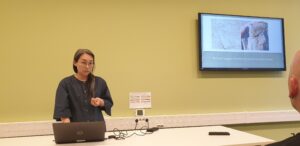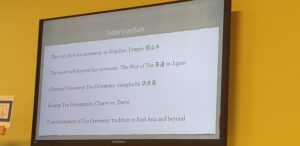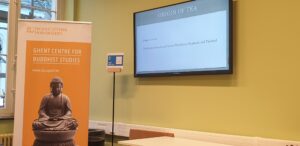As part of the Permanent Training in Buddhist Studies lecture series, Prof. Jin Kyoung Choi (Ghent Centre for Buddhist Studies) delivered a talk titled “Buddhist Material Culture in East Asian Tea Tradition: The Way of Tea, the Art of Tea, and Tea Ceremony” on Tuesday, 29 April 2025, at the Faculty Library of Arts and Philosophy, Ghent University.
This rich and insightful lecture traced the historical and cultural evolution of the tea ceremony across East Asia, unfolding in five compelling chapters. Prof. Jin began at the spiritual heart of China’s tea culture: Jingshan Temple 径山寺 in Hangzhou, which is widely recognized as the birthplace of the formal tea ceremony. The lecture then took us across the sea to Japan, where Chinese tea culture took on a new life. During the Northern Song dynasty, powdered tea (Ch. mǒchá; J. macha 抹茶) was brought to Japan by monks and evolved into the world-renowned Japanese tea ceremony. Known as chadō 茶道—the Way of Tea—it became deeply embedded in Zen Buddhist practice and Japanese aesthetics. Turning back to the Sinosphere, the focus shifted to gongfucha 功夫茶, the high-skill brewing method that originated in the Chaozhou region of Guangdong. This practice was carried to Taiwan, where it took root and evolved. Oolong tea, in particular, became Taiwan’s most celebrated varietal.
An especially intriguing part of the lecture explored how modern Chinese and Taiwanese societies are negotiating the cultural legacies of tea. The term chadō is rarely used in contemporary China or Taiwan due to its strong association with Japanese tea tradition. Instead, Taiwan promotes chayi 茶艺(art of tea), emphasizing artistic expression and cultural refinement, while mainland China has been working to revive the ancient Song-style powdered tea ceremony as a distinct national heritage. The lecture also shed light on Korea’s distinct tea practices, charye and darye.


